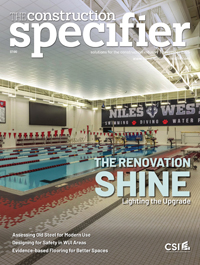Customize acoustic ceilings with specialty coatings

the ceiling to a new white surface finish.
Images courtesy Ken Woolf
Acoustical wall panels
Acoustical panels mounted on walls can provide an excellent means of noise reduction. Under certain conditions, they can be treated with an acoustical coating either for purposes of restoration or by providing designer colors in new construction.
However, there are some limitations. The chemical formulation of an acoustical coating is significantly different from those of conventional paints. One of those differences is in the reduced use of binders and other elements affecting the surface tension. This is critical because the acoustical coating must leave the surface pores open in the material, as opposed to the harder paints that tend to bridge them. This brings the limitation to the fore. With the decreased use of binders, the result is a softer surface that does not hold up well to scrubbing.
On a ceiling, repeated scrubbing is seldom an issue, but on a wall where stains are common, maintenance personnel will frequently attempt to scrub the panels clean and wear down the coated surface. Therefore, the acoustical coating should not be applied where it may be subjected to scrubbing. The architect must decide what is the most important consideration—scrubability or acoustical performance.
With all of this in mind, architects wishing to maximize the sound absorbing areas will use the acoustical coating on wall panels down to a point approximately 2 m (6 ft) above the floor, and from there down, introduce another treatment. A contrasting paint color on a harder surface or even a paneling system (wainscoting) are examples of what can be done from the floor up to the 2-m level.
Honoring the spec
An architect specifies a particular product because it best satisfies the need for performance and appearance for a project. It is difficult when the specification is disregarded by someone down the line who takes it upon themselves to make an unauthorized substitution. It is an age-old problem particularly prevalent in the application of coatings of all sorts.
When opting for an acoustical coating, it should be noted inexpensive dry-fall paint can also be used if no consideration is given to the many negative effects on performance. To save money, many contractors will make the substitution, thinking no one will know the difference. This is frustrating to the architect, manufacturer of the specified product, and, ultimately, the end-user.
Some manufacturers have responded to this problem by developing CSI-formatted specifications for high-quality acoustical coatings, and then making them available to design professionals.
In the author’s experience, there is an improved conformance with the specified products when the CSI-formatted specs are used by architects. This appears to have been the best solution thus far to the extent many architects have begun using the same provisions regarding other products they wish to protect against unauthorized substitutions. It is advisable to ask the manufacturer if they have such a specification.
Benefits of a brighter ceiling
Many design professionals would maintain, in the white color, the most valuable characteristic of the better acoustical coating is the ability to disperse light sufficiently to reduce the dependence on artificial lighting. In Figure 1, it is easy to note the improved color of the walls and merchandise due to the ceiling having been treated to a new, white surface finish.
Quality coatings can hold the color longer than traditional ceiling-white paints, making for a more impressive life cycle, and have a better-than-average ability to disperse light. When the available light is dispersed effectively, it results in less dependence on artificial lighting (with an associated energy reduction), and particularly in a retail setting, merchandise seen in a truer color.



